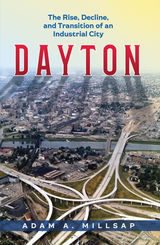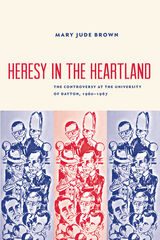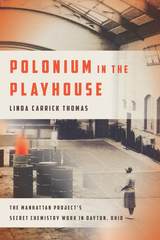5 books about Dayton

America Lost and Found
An English Boy's Wartime Adventure in the New World
Anthony Bailey
University of Chicago Press, 2000
In 1940 seven-year-old Tony Bailey was evacuated to the United States—one of more than 16,000 children sent overseas at a time when a Nazi invasion of England seemed inevitable. He spent four years with the wealthy Spaeth family in Dayton, Ohio, before returning to his parents in Southampton. Evocative, heartfelt, and charming, this is a story of a double childhood—of a boy who became American while never ceasing to be British.
"An original, sensitively told story in which the perspectives of the child are carefully remembered. . . . Bailey's book speaks, with gentle eloquence, not only to those who remember being boys, but to everyone who would seek to protect children from the hurts and ravagings that ordinary life can inflict, to say nothing of war." —Richard Montague, Newsday
"No doubt Tony Bailey owed America something for its hospitality during those anxious years, and with this book he has amply repaid the debt." —Joseph McLellan, Washington Post
"An exquisitely controlled, quietly amusing and moving story." —Publishers Weekly
"As tender as it is truthful, and as amusing as it is unpretentious." —John Russell, New York Times Book Review
"An original, sensitively told story in which the perspectives of the child are carefully remembered. . . . Bailey's book speaks, with gentle eloquence, not only to those who remember being boys, but to everyone who would seek to protect children from the hurts and ravagings that ordinary life can inflict, to say nothing of war." —Richard Montague, Newsday
"No doubt Tony Bailey owed America something for its hospitality during those anxious years, and with this book he has amply repaid the debt." —Joseph McLellan, Washington Post
"An exquisitely controlled, quietly amusing and moving story." —Publishers Weekly
"As tender as it is truthful, and as amusing as it is unpretentious." —John Russell, New York Times Book Review
[more]

Dayton
The Rise, Decline, and Transition of an Industrial City
Adam A. Millsap
The Ohio State University Press, 2019
The Rust Belt was once the crown of American manufacturing, a symbol of the country’s economic prowess. But now it is named for what it has become: a deteriorating stretch of industrial cities left behind by a post-industrial world. In Dayton: The Rise, Decline, and Transition of an Industrial City, Adam A. Millsap turns his focus to his hometown, an archetypal Rust Belt city, to examine its history and discuss its future.
Thoroughly researched and engagingly written, Millsap’s book explores the economic background of the region made famous by J. D. Vance’s Hillbilly Elegy. From early twentieth-century optimism, through the Great Depression and post-WWII manufacturing decline, to Dayton now, with its labor-force problems and opioid crisis, Millsap tracks the underlying forces driving the city’s trajectory. Race relations, interstates, suburbanization, climate, crime, geography, and government policies all come into play as Millsap develops a picture of the city, past and present. By examining the past, Millsap proposes a plan for the future, claiming that there is hope for Dayton to thrive again. And if Dayton can rise from its industrial ashes, then perhaps the Rust Belt can shed its stigma and once again become the backbone of American innovation.
Thoroughly researched and engagingly written, Millsap’s book explores the economic background of the region made famous by J. D. Vance’s Hillbilly Elegy. From early twentieth-century optimism, through the Great Depression and post-WWII manufacturing decline, to Dayton now, with its labor-force problems and opioid crisis, Millsap tracks the underlying forces driving the city’s trajectory. Race relations, interstates, suburbanization, climate, crime, geography, and government policies all come into play as Millsap develops a picture of the city, past and present. By examining the past, Millsap proposes a plan for the future, claiming that there is hope for Dayton to thrive again. And if Dayton can rise from its industrial ashes, then perhaps the Rust Belt can shed its stigma and once again become the backbone of American innovation.
[more]

FEMINISM IN THE HEARTLAND
JUDITH EZEKIEL
The Ohio State University Press, 2002

Heresy in the Heartland
The Controversy at The University of Dayton, 1960-67
Mary Jude Brown
Catholic University of America Press, 2022
Heresy in the Heartland is a narrative case study of the 'Heresy' Affair at the University of Dayton, a series of events predominantly in the philosophy department that occurred when tensions between the Thomists and proponents of new philosophies reached crisis stage in fall 1966. The controversy culminated in a letter written by a lay assistant professor to the Cincinnati archbishop, Karl J. Alter. In the letter, the professor cited a number of instances where “erroneous teachings” were “endorsed” or “openly advocated” by four lay faculty members. Concerned about the pastoral impact on the University of Dayton community, the professor asked the archbishop to conduct an investigation. How the University weathered this controversy, the second of three major controversies to hit Catholic higher education within three years (St. John’s University, University of Dayton and the Curran affair at Catholic University of America), is of interest to faculty and administrators in Catholic higher education who continue to struggle with defining what it means to be a “Catholic” university, with the relationship of Catholic universities to the Church at large and the hierarchy in particular, and with Church teachings that conflict with the culture we live in such as immigration, the environment and sexual ethics.
The story is told in chronological order by the participants in the controversy - faculty, administrators, students and clergy - using the words of those involved. Heresy in the Heartland concludes with a synopsis of what happened at the University of Dayton and draws some lessons for the future of Catholic higher education.
[more]

Polonium in the Playhouse
The Manhattan Project's Secret Chemistry Work in Dayton, Ohio
Linda Carrick Thomas
The Ohio State University Press, 2017
At the height of the race to build an atomic bomb, an indoor tennis court in one of the Midwest’s most affluent residential neighborhoods became a secret Manhattan Project laboratory. Polonium in the Playhouse: The Manhattan Project's Secret Chemistry Work in Dayton, Ohio presents the intriguing story of how this most unlikely site in Dayton, Ohio, became one of the most classified portions of the Manhattan Project.
Seized by the War Department in 1944 for the bomb project, the Runnymede Playhouse was transformed into a polonium processing facility, providing a critical radioactive ingredient for the bomb initiator—the mechanism that triggered a chain reaction. With the help of a Soviet spy working undercover at the site, it was also key to the Soviet Union’s atomic bomb program.
The work was directed by industrial chemist Charles Allen Thomas who had been chosen by J. Robert Oppenheimer and General Leslie Groves to coordinate Manhattan Project chemistry and metallurgy. As one of the nation’s first science administrators, Thomas was responsible for choreographing the plutonium work at Los Alamos and the Project’s key laboratories. The elegant glass-roofed building belonged to his wife’s family.
Weaving Manhattan Project history with the life and work of the scientist, industrial leader and singing-showman Thomas, Polonium in the Playhouse offers a fascinating look at the vast and complicated program that changed world history and introduces the men and women who raced against time to build the initiator for the bomb.
Seized by the War Department in 1944 for the bomb project, the Runnymede Playhouse was transformed into a polonium processing facility, providing a critical radioactive ingredient for the bomb initiator—the mechanism that triggered a chain reaction. With the help of a Soviet spy working undercover at the site, it was also key to the Soviet Union’s atomic bomb program.
The work was directed by industrial chemist Charles Allen Thomas who had been chosen by J. Robert Oppenheimer and General Leslie Groves to coordinate Manhattan Project chemistry and metallurgy. As one of the nation’s first science administrators, Thomas was responsible for choreographing the plutonium work at Los Alamos and the Project’s key laboratories. The elegant glass-roofed building belonged to his wife’s family.
Weaving Manhattan Project history with the life and work of the scientist, industrial leader and singing-showman Thomas, Polonium in the Playhouse offers a fascinating look at the vast and complicated program that changed world history and introduces the men and women who raced against time to build the initiator for the bomb.
[more]
READERS
Browse our collection.
PUBLISHERS
See BiblioVault's publisher services.
STUDENT SERVICES
Files for college accessibility offices.
UChicago Accessibility Resources
home | accessibility | search | about | contact us
BiblioVault ® 2001 - 2024
The University of Chicago Press









